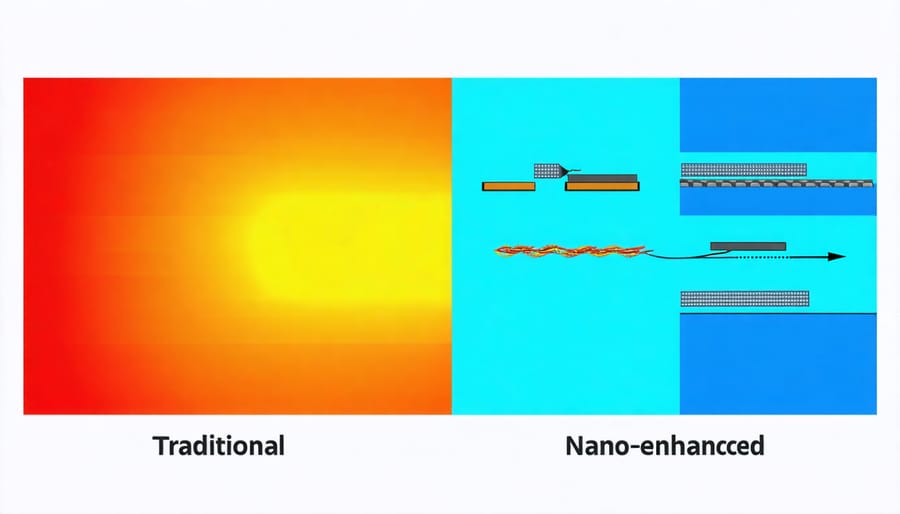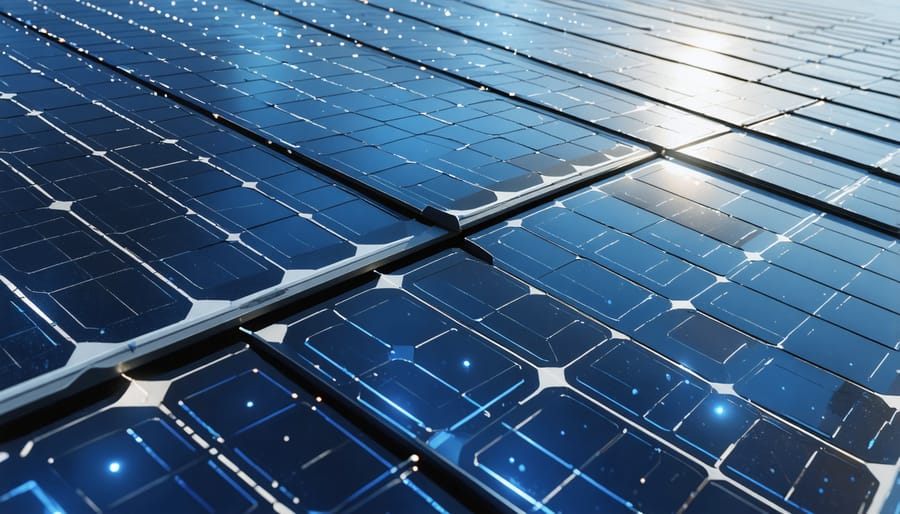How Nano-Materials Are Revolutionizing Solar Panel Efficiency

Materials nanotechnology stands at the forefront of solar energy innovation, revolutionizing how we harness and convert sunlight into electricity. At the nanoscale—where materials are manipulated at dimensions of billionths of a meter—extraordinary properties emerge that dramatically enhance solar cell efficiency and durability. These advances are transforming conventional silicon-based panels into next-generation photovoltaic systems that capture a broader spectrum of light while requiring less raw material.
European research laboratories and manufacturers are pioneering breakthrough developments in nano-engineered surfaces that reduce light reflection, quantum dot structures that maximize photon absorption, and self-cleaning nanocoatings that maintain peak performance. These innovations have already enabled commercial solar panels to exceed 26% efficiency, with laboratory prototypes approaching the theoretical limit of 33% for single-junction cells.
The impact extends beyond mere efficiency gains. Nanomaterials are enabling flexible, lightweight solar panels that can be integrated into building materials, vehicles, and even clothing. This versatility, combined with reduced production costs and improved durability, positions nanotechnology as a crucial driver in Europe’s transition to renewable energy, supporting the EU’s ambitious goal of climate neutrality by 2050.
The Science Behind Nano-Enhanced Solar Materials
Key Nanomaterials in Modern Solar Panels
Modern solar panels are experiencing a revolutionary transformation through the integration of advanced nanomaterials. Quantum dots in solar technology represent one of the most promising innovations, offering enhanced light absorption and improved energy conversion efficiency. These semiconductor nanocrystals can be precisely tuned to capture specific wavelengths of light, potentially increasing panel efficiency by up to 20%.
Carbon nanotubes serve as excellent electron transporters within solar cells, significantly reducing electrical resistance and improving overall performance. Their unique cylindrical structure, measuring just a few nanometers in diameter, creates highly efficient pathways for electricity to flow, minimizing energy losses common in traditional solar panels.
Plasmonic nanostructures, typically made from noble metals like gold and silver, are revolutionizing light management in solar cells. These structures create localized surface plasmons that effectively trap and concentrate sunlight, allowing for thinner solar cells without sacrificing performance. European research institutes have demonstrated that incorporating plasmonic nanoparticles can enhance light absorption by up to 15% in conventional silicon solar cells.
Perovskite quantum dots are emerging as game-changers in solar technology, offering the potential for higher efficiency at lower production costs. These materials demonstrate exceptional light-harvesting capabilities and can be manufactured using solution-processing techniques, making them particularly attractive for large-scale European solar installations.
The integration of these nanomaterials is not just about improving efficiency; it’s about creating more sustainable and durable solar solutions. Advanced coating technologies using nanoparticles are helping to develop self-cleaning surfaces and anti-reflective layers, extending panel lifespan and maintaining optimal performance in various European climate conditions.

Light-Capturing Innovations at the Nanoscale
At the nanoscale, revolutionary light-capturing innovations are transforming solar technology efficiency. Nano-structured materials create sophisticated light-trapping mechanisms that significantly enhance photon absorption. These structures, often just a few nanometers in size, can capture and guide light in ways that conventional materials cannot.
One key breakthrough involves the development of nano-textured surfaces that create multiple pathways for light to travel, dramatically reducing reflection and increasing the chance of photon absorption. European research institutes have pioneered the use of nano-pyramids and nano-wires that can capture light from various angles, making solar panels more efficient even in low-light conditions.
Another significant advancement is the implementation of quantum dots and plasmonic nanoparticles. These nano-scale elements can be precisely tuned to absorb specific wavelengths of light, allowing for broader spectrum utilization. When integrated into solar cells, they create additional absorption bands, effectively harvesting energy that would otherwise be lost.
These nanoscale innovations are particularly relevant for European markets, where varying weather conditions and seasonal changes demand highly efficient light-capturing solutions.
Performance Breakthroughs with Nanotechnology

Efficiency Gains Through Nano-Engineering
Nano-engineering has revolutionized solar panel technology, delivering dramatic efficiency improvements through precise material manipulation at the molecular level. Recent developments in European laboratories have achieved remarkable results, with nano-engineered surfaces increasing light absorption by up to 20% compared to conventional panels.
One striking example is the implementation of quantum dot technology, which has enhanced electron capture rates by 35% in laboratory conditions. These microscopic semiconductor particles, when integrated into solar cell designs, enable the harvesting of a broader spectrum of light wavelengths, significantly boosting energy conversion capabilities.
Anti-reflective nanocoatings have emerged as another game-changing innovation, reducing surface reflection from 30% to less than 1%. This breakthrough, developed by researchers in Germany, translates to approximately 10% more energy capture during peak sunlight hours. Additionally, self-cleaning nanostructures inspired by lotus leaves have reduced maintenance requirements while maintaining optimal performance levels.
Carbon nanotube implementations in solar cell architecture have demonstrated a 15% increase in electrical conductivity, leading to reduced energy loss during transmission. These improvements, combined with nano-enhanced battery storage systems, have pushed overall system efficiency beyond 25% in real-world applications across European installations.
The integration of plasmonic nanoparticles has enabled thinner, more flexible solar panels while maintaining high efficiency rates. This innovation has reduced material costs by up to 30% while expanding installation possibilities for curved surfaces and building-integrated applications, making solar technology more accessible and versatile for European consumers and industries.
Durability and Lifespan Benefits
Nanotechnology has revolutionized the way we approach solar panel longevity, particularly in addressing common durability challenges. By incorporating nanomaterials into panel construction, manufacturers have achieved remarkable improvements in weather resistance and overall lifespan.
The application of nano-coatings creates an ultra-thin protective layer that shields panels from harsh environmental conditions. These coatings exhibit self-cleaning properties, preventing dust and debris accumulation while maintaining optimal light absorption. Additionally, nanostructured materials enhance resistance to UV degradation, a primary factor in panel deterioration over time.
European research has demonstrated that nano-enhanced panels show up to 30% better resistance to mechanical stress compared to conventional panels. The integration of carbon nanotubes and graphene-based materials strengthens the structural integrity of solar cells, reducing micro-cracks and delamination risks.
Perhaps most importantly, nanomaterial treatments significantly improve moisture resistance. Advanced hydrophobic nano-coatings prevent water infiltration, dramatically reducing the risk of internal corrosion and electrical degradation. This innovation is particularly valuable in regions with high rainfall or humidity levels, where traditional panels often struggle to maintain peak performance.
These durability enhancements translate to extended operational lifespans, with some nano-enhanced panels showing promising results in accelerated aging tests, suggesting potential service lives of 30+ years while maintaining high efficiency levels.
European Innovation in Solar Nanotechnology
Leading Research Initiatives
Europe stands at the forefront of materials nanotechnology research, with several groundbreaking initiatives reshaping the solar energy landscape. The Horizon Europe programme has allocated substantial funding to nano-materials research, supporting projects that enhance solar cell efficiency through innovative surface treatments and novel semiconductor compositions.
Notable achievements include the development of perovskite-silicon tandem cells at the Swiss Federal Institute of Technology (EPFL), which achieved a remarkable 29.2% efficiency rate. The European Nanostructured Materials and Processes (ENMAP) consortium has successfully pioneered self-cleaning nanocoatings that reduce maintenance requirements while improving light absorption.
In Germany, the Fraunhofer Institute’s work on quantum dot solar cells has yielded promising results in harvesting a broader spectrum of solar energy. Meanwhile, Dutch researchers at Delft University of Technology have made significant progress in developing transparent conducting oxides using atomic layer deposition techniques, enabling better integration of solar technology into building materials.
The collaborative NanoSolveIT project, involving 15 European research institutions, focuses on developing sustainable nanomaterials for next-generation solar applications. Their work includes creating comprehensive safety frameworks and standardization protocols for nano-enhanced solar technologies, ensuring responsible innovation in the field.
These research initiatives demonstrate Europe’s commitment to advancing sustainable energy solutions through materials nanotechnology, with practical applications already emerging in commercial solar installations across the continent.
Commercial Applications
Nanotechnology has already made significant inroads into various commercial sectors, with the solar industry leading adoption. Major European manufacturers now incorporate nano-structured materials in their photovoltaic panels, achieving efficiency improvements of up to 25% compared to conventional designs. These implementations include anti-reflective coatings, enhanced light-trapping layers, and nano-engineered conductors.
Beyond solar applications, nanomaterials are revolutionizing energy storage solutions, with several European startups developing high-capacity batteries using nano-structured electrodes. The construction industry has embraced self-cleaning windows and facades utilizing titanium dioxide nanoparticles, while automotive manufacturers implement nano-coatings for improved durability and reduced maintenance.
Looking ahead, emerging applications include smart textiles with integrated nano-sensors, advanced water filtration systems, and next-generation electronic displays. The European Union’s commitment to sustainable technology has accelerated commercialization through targeted funding initiatives and industry partnerships. Market analysts project the global nanotechnology materials market to reach €75 billion by 2025, with European innovations driving significant growth in renewable energy and sustainable building materials sectors.
Future Prospects and Implementation
Next-Generation Technologies
The landscape of materials nanotechnology is rapidly evolving, with several groundbreaking innovations poised to revolutionise solar energy systems. European research laboratories are currently developing emerging solar materials that promise to dramatically enhance energy conversion efficiency and durability.
Quantum dot solar cells represent one of the most promising developments, utilizing precisely engineered nanocrystals that can capture a broader spectrum of light. These microscopic semiconductors can be tuned to specific wavelengths, potentially increasing panel efficiency by up to 45%.
Perovskite-based technologies are advancing rapidly, with researchers developing stable, high-performance materials that can be manufactured at significantly lower costs. Recent breakthroughs in perovskite-silicon tandem cells have achieved conversion efficiencies exceeding 29%, setting new industry benchmarks.
Self-cleaning nanocoatings are emerging as another game-changing technology. These hydrophobic surfaces, inspired by lotus leaves, use nanoscale structures to repel water and debris, maintaining optimal panel performance while reducing maintenance requirements.
Carbon nanotubes and graphene-based materials are being integrated into next-generation solar cells, offering enhanced conductivity and structural stability. These materials show particular promise for flexible solar applications, opening new possibilities for building-integrated photovoltaics across European architecture.

Integration Challenges and Solutions
While nano-enhanced solar panels offer remarkable potential, their integration into existing systems presents several key challenges that require careful consideration. The primary hurdle lies in maintaining consistent quality during large-scale manufacturing processes, as nanomaterials must be uniformly distributed to ensure optimal performance. European manufacturers have developed specialized coating techniques and quality control measures to address this challenge.
Installation requirements also demand attention, as nano-enhanced panels may need specific mounting orientations or additional protective measures against environmental factors. To combat this, innovative mounting systems and protective coatings have been developed specifically for European weather conditions.
Cost considerations remain significant, though economies of scale are gradually reducing the price premium of nano-enhanced panels. Many European nations offer incentives and subsidies to offset initial investments, making adoption more feasible for both homeowners and businesses.
Maintenance protocols require updating, as these advanced panels may need different cleaning methods and handling procedures. Industry experts recommend professional cleaning services familiar with nanotechnology-based systems to maintain optimal performance.
Integration with existing power systems has been streamlined through advanced inverter technologies and smart monitoring systems, ensuring compatibility with both residential and commercial installations. European certification bodies have established clear guidelines for installers, making the transition to nano-enhanced solar technology more straightforward and reliable.
Materials nanotechnology stands at the forefront of Europe’s solar energy revolution, promising to reshape our approach to renewable energy generation. Through innovative applications in solar cell design, we’re witnessing unprecedented improvements in energy conversion efficiency, durability, and cost-effectiveness. These advancements are particularly significant for European nations committed to achieving their ambitious climate goals by 2030 and beyond.
The integration of nanotechnology in solar materials has already demonstrated remarkable results, with efficiency improvements of up to 25% in laboratory settings. This progress directly translates to more affordable and accessible solar solutions for homeowners and businesses across Europe. Moreover, the development of self-cleaning surfaces and enhanced durability through nanocoatings means reduced maintenance costs and longer system lifespans.
Looking ahead, the impact of materials nanotechnology on solar energy cannot be overstated. As research continues and manufacturing processes become more refined, we can expect to see even more breakthrough innovations. The European Union’s commitment to green energy transition, coupled with substantial investment in nanotechnology research, positions Europe as a global leader in sustainable energy solutions.
For European stakeholders, from individual homeowners to large industrial facilities, these developments represent not just technological advancement but a practical pathway to energy independence and sustainability. As we move forward, materials nanotechnology will continue to play a crucial role in making solar energy more efficient, affordable, and accessible across the continent.
Leave a Reply